Core Content Strategy: How to Create More Resonance, Respect, Power, and Profitability with Pillar Content

Forgive me in advance for being blunt. You are a busy person and I want to respect your time by getting to the point.
Your marketing plan has a gaping hole it.
You run a consulting firm, agency, company, or “shop”. You offer high-priced premium services and packaged consulting advice. You've bought into the concept of building thought leadership and attracting clients through content (inbound) marketing.
You've got ebooks, infographics, whitepapers articles, etc. You've got all of the stuff. You've followed all of the advice.
And in the process of making all the “content” and setting up all the “systems” no one was brave enough to tell you the brutal truth about your core content strategy.
Your content is weak.
You aren't weak. Your content is weak.
Your services aren't weak. Your content is weak.
Your expertise isn't weak. Your content is weak.
Here is the rub: Your prospective clients are using your content to decide if they should work with you. If your content is weak they will assume you are weak. Do you see the problem here?
Bottom line: no one buys the second best option.
...and if your company is seen as the second best option no one is buying from YOU.
Have you ever
...walked into a car dealership and asked for the 2nd best car on the lot?
...asked a realtor to show you the 5th best house in their inventory?
...sat down at a restaurant and ordered the 4th best item on the menu?
Of course not. And why is that?
Because no one buys the second best option. People want to associate themselves with the “best” and your prospective client is no different. Your prospective client is looking for the best solution to his specific problem.
So then...
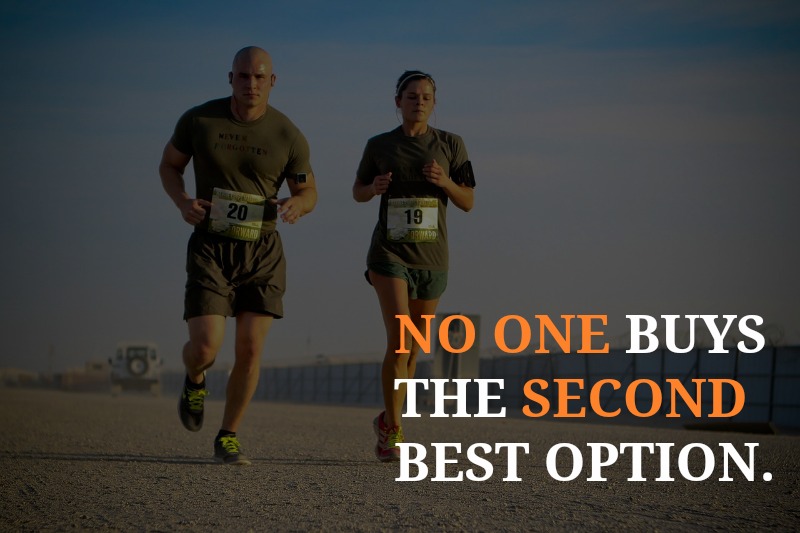
If you are going to use content to attract more (and better) clients you need to position yourself as the obvious, best-in-class solution.
Every piece of content you create must support your claim as the best-in-class option.
Intuitively you know this, but doing it is a much more difficult (and robust) task.
Best-in-class doesn't happen on accident. It happens on purpose. You must PLAN for it.
This article offers the 4 questions you (the leader) must answer to make it abundantly clear that your company provides the best solution to your prospective client's painful problem.
Proof: What it looks like when you get it right.

Meet Amin Aleem, founder of Cornerstone Bookkeeping and Accounting. Initially, he approached the market like everyone else. His firm offered boring, standard, and undifferentiated bookkeeping services. He was using his precious energy to network (schmooze), build up word of mouth (pray for referrals), and bid (beg) for business.
His margins were low, new business opportunities were slow, and truthfully, he was nervous about the firm's ability to grow predictably.
He made a decision to take a step back, reposition his firm, and scale up the value he offered to the marketplace.
Specifically he refined his core message and created education based, pillar content pieces to attract his next level clientele.
Visually, the process looks like this:

And he got RESULTS.
Here are a just a couple of snapshots of the lead generation results his firm is currently experiencing.
August 2015 Campaign: 11 New Leads In 30 Days...

October 2015 Campaign: 14 New Leads in 7 Days...

...and most importantly
His content sets a context for how next level clients will engage with his firm. The education based, pillar content pieces have:
- Formalized his client acquisition process. Prospective clients are first introduced to his company through education based content. No need for networking or cold calling.
- Sharpened his method for delivering high-level service to clients. The pre-defined packages eliminate the need for billable hours, customized projects, or long bidding cycles.
- Converted more satisfied clients into ongoing revenue. Clients understand how his services connect and are excited to extend their relationship with long-term retainer arrangements.
His goal this year is to bring on $250,000 in new revenue...just from this one concept.
Who is HE to set those kinds of goals? What makes him so confident these goals are within his reach?
Keep reading. Let's see if this makes sense for YOU.

Warning: This is a conversation is for leaders ONLY
You are the main messenger, rainmaker, and fearless leader. You are responsible for the core strategy and messaging that drives your business. Your clarity defines the power, impact, speed, virality, and profitability of your business.
What's the problem? How do you know you've become the dreaded “second best” option?
Your keynote presentations are standard, boring, and uninteresting. You drone on and on with your PowerPoint slides and you can actually SEE peoples' eyes glaze over.
Your content pieces (blog, articles, and social media platforms) aren't getting much traction. Sometimes you (finally get around to) write content and other times you outsource the content (and pray it's good). Either way, you are getting “blah” results.
Your personal introductions fall flat. Introducing your company as ________ consultants earns you general disinterest. When you try to explain a bit more, your 30 second elevator pitch turns into a 30 minute verbal dissertation. #fail
Why do others seem to be doing SO well?
THEIR content feels fluid and clever. YOUR content feels clunky and salesy.
THEIR content feels present and authentic. YOUR content feels forced and scripted.
THEIR content earns likes, shares, and sales conversions. YOUR content doesn't move the needle at all.
In short, it feels like their content “just works” and yours “just doesn't”.
What are they doing that you aren't?
- It ain't software tools. You've got more of those than you can shake a stick at.
- It ain't experience. You've spent most of your life honing your expertise. You know your stuff.
- It ain't desire. Hard work? C'mon son. You've never been afraid of hard work.
So what the heck is it?
"They" are courageous enough to commit to a core message.
"They" are disciplined enough to support their core message with a strategic content plan.
And I'm not talking about some flimsy, one page I-wrote-it-in-15-minutes-type plan.
I'm also not talking about some 139 page behemoth you wrote to impress your friends and colleagues.
I'm talking about a simple (and powerful) set of documents that serve as the center of all your business communication. This is the “rally cry” that galvanizes your employees, vendors, clients, and other stakeholders.
But, let's be honest. You don't have a plan.
If content marketing is the practice of using content to express your core beliefs and build a community of clients around those beliefs...then content marketing is VERY important...but most haven't spent the time, energy, or effort to document a winning approach.
How do I know you don't have a documented plan? Content Marketing Institute did the research. They found that only 32% of B2B organizations have a documented content marketing plan.
-
More stats from the presentation:
- 88% of marketers use content marketing.
- Only 30% of content marketers consider themselves best in class.
- 67% of marketers consider their content marketing maturity level at adolescent or below
- 68% of marketers don’t have a documented content marketing strategy
I know...there is NO shortage of experts telling you to create a content marketing plan. Experts tell you to create a content calendar, build a content team, use “special” tools, find the right keywords, create an avatar, publish on a variety of different sites, etc
But if your core message (and content strategy) is going to be of any use you must FIRST articulate what you believe.
You've got to draw a line in the sand.
You've got to stake your claim in the market.
You've got to make a bold promise to solve a legitimate problem for a real person that is in pain.
And getting to this level of clarity is not a 30 second microwaveable process.
It's a strategic process that begins with discovery.
The Four Core Questions
[Document Your Plan of Attack]
Question 1: What problem are you uniquely positioned to solve?
Every year, the President of the United States comes forward to present his State of the Union address. He assesses our marketplace, prioritizes the issues, and brings them to our attention so we know what to focus on.
What is your assessment of the marketplace?
What problems MUST be fixed?
Why are these issues are most pressing?
Where have you heard this before?
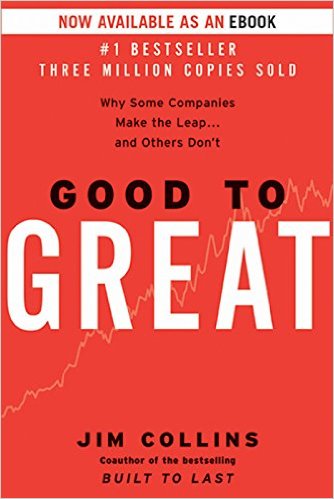 You might be familiar with this concept from Jim Collin's book Good to Great. He spent five-years doing quantitative research comparing companies that made the leap from “good” to “great”. One of the essential tasks performed by the leader was to “confront the brutal facts” about the company's state of affairs.
You might be familiar with this concept from Jim Collin's book Good to Great. He spent five-years doing quantitative research comparing companies that made the leap from “good” to “great”. One of the essential tasks performed by the leader was to “confront the brutal facts” about the company's state of affairs.

"You absolutely cannot make a series of good decisions without first confronting the brutal facts."
-Jim Collins, Author Good to Great
State of the Union Example: Confront the Brutal Facts

"I must say to you that the state of the Union is not good."
-President Gerald Ford, State of the Union 1975
Though brutal, he owed it to the nation to tell them the truth. He supported his assessment with a string of facts, “Millions of Americans are out of work. Recession and inflation are eroding the money of millions more. Prices are too high, and sales are too slow. This year's federal deficit will be about $30 billion; next year's probably $45 billion. The national debt will rise to over $500 billion…” He would later move on to highlight some encouraging statistics, but it was incredibly important to call out the truth first.
Question 2: Why should a client choose you over the obvious competition?
If you are honest, you'll admit your company faces competition. If you are really honest, you'll admit you and your competition look a lot alike. If you are brutally honest you'll admit you and your competition look almost identical (like twins even) and it's extremely hard to tell you two apart. Competition is real but you do not have to accept sameness as your reality. Fight through the obvious similarities. Every company is unique in some way!
Can you claim specific points of value your competition cannot emulate?
What is the driving force behind why your company chooses to serve the way it does?
Where have you heard this before?
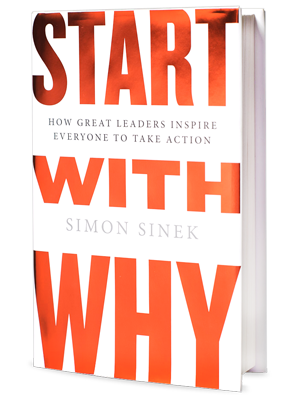 Simon Sinek highlights this concept in his book “Start with Why”. One of the most popular concepts from the book encourages companies to first communicate “why they do what they do” before explaining “what they do” or “how they do it”. This model explains how two companies (Microsoft vs Apple) can begin with the same concept (build a laptop computer) and create two specifically different results.
Simon Sinek highlights this concept in his book “Start with Why”. One of the most popular concepts from the book encourages companies to first communicate “why they do what they do” before explaining “what they do” or “how they do it”. This model explains how two companies (Microsoft vs Apple) can begin with the same concept (build a laptop computer) and create two specifically different results.

“People don't buy what you do; they buy why you do it. And what you do simply proves what you believe.”
-Simon Sinek, Author Start With Why
Confess Your "Why" Example: Microsoft vs Apple
Steve Jobs and Apple believe “design thinking" drives deeper than how a product looks. Their products have a reputation for being sleek from their product packaging down to their operation system. Apple gives you every opportunity to feel and experience their beliefs.

“If you can't make it good, at least make it look good."
- Bill Gates, Microsoft

“Design is not just what it looks like and feels like. Design is how it works.”
- Steve Jobs
Question 3: Who is in the most pain because they don't have your solution?
There is a unique pocket of people, with a very particular pain, anxiously awaiting the arrival of your unique perspective. They have gone as far as they can go...but without your help...they will be perpetually stuck. You understand their special concerns. You can speak to their individual challenges. You've got to find a way to reach the people who need your service most.
Can you accurately describe the acute suffering your potential client experiences?
Can you pinpoint a location where your potential clients gather in a group?
Where have you heard this before?
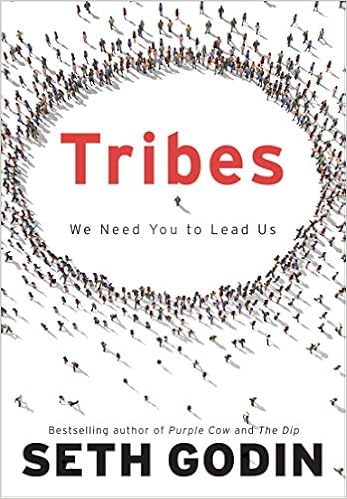 Seth Godin's book Tribes focuses on this concept. The tagline simply says, “We Need You to Lead Us”. Where tribes used to be localized with geographic limitations, the internet has radically changed that dynamic. Now people from all over the world with similar concerns can communicate and congregate through a variety of online channels. Find your people. Step forward to lead them.
Seth Godin's book Tribes focuses on this concept. The tagline simply says, “We Need You to Lead Us”. Where tribes used to be localized with geographic limitations, the internet has radically changed that dynamic. Now people from all over the world with similar concerns can communicate and congregate through a variety of online channels. Find your people. Step forward to lead them.

“Leaders lead when they take positions, when they connect with their tribes, and when they help the tribe connect to itself.”
― Seth Godin, Author of Tribes: We Need You to Lead Us
Find Your Tribe Example: Where can a Fitness Coach Find a Focused, Targeted Male Audience?
How do you find the audience tailor made for you? We found 198,000 college educated, single men in the age range 18-34. They all live in the United States with expressed interest in Men's Fitness magazine and The 4 Hour Body by Tim Ferris. Does that sound like your tribe?
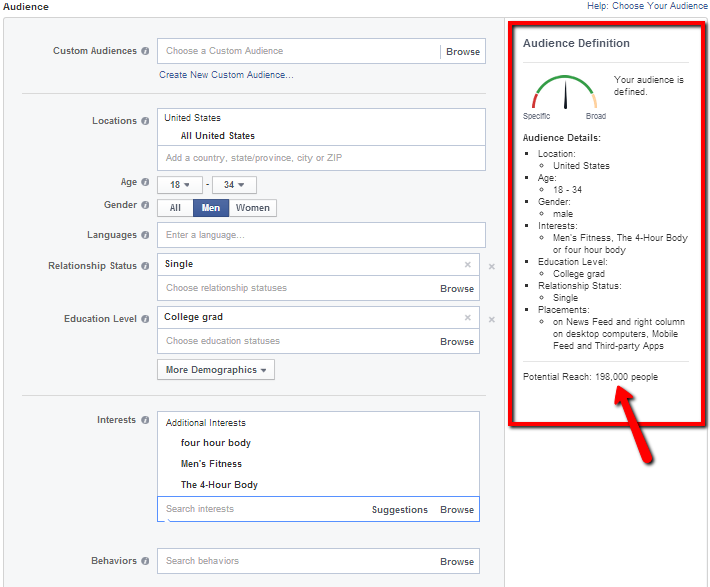
Question 4: How can you promise excellence each and every time?
For service based companies, every new client engagement can feel like starting your company from scratch. Bringing on a new client requires you to endure multiple meetings, conduct a needs analysis, write a proposal, and lay out the costs. Each time you have to reinvent your service to fit the unique needs of the new client. Is this really the most efficient use of your time or your client's spend? What if you re-engineered (productized) your services to deliver the highest amount of impact with the fewest number of moving parts? It's time to refocus.
How many high-level clients can you serve at once? Does that number exhaust you?
Does the quality of your service decline with each new client you bring on?
What is the five-star, top of the line, best-in-class service you should focus on?
Where have you heard this before?
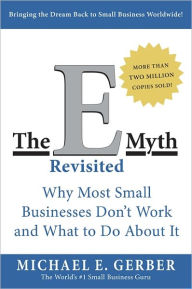 E-Myth Revisited tells the story of Sarah who runs “All About Pies”. She makes an excellent product, but is overwhelmed by the number of moving parts in her business. It wears her down and threatens the consistent quality of the pies she serves. The book introduces a core set of systems so she can begin to work on her business not just in her business. (Cliche I know, but it's not funny when your business dominates your entire life. If I'm describing you it's time to commit to a plan for change.)
E-Myth Revisited tells the story of Sarah who runs “All About Pies”. She makes an excellent product, but is overwhelmed by the number of moving parts in her business. It wears her down and threatens the consistent quality of the pies she serves. The book introduces a core set of systems so she can begin to work on her business not just in her business. (Cliche I know, but it's not funny when your business dominates your entire life. If I'm describing you it's time to commit to a plan for change.)

“If your business depends on you, you don’t own a business—you have a job. And it’s the worst job in the world because you’re working for a lunatic!”
― Michael E. Gerber, Author The E-Myth Revisited
Example of a Productized Service: Domino's Pizza
As a part of Domino's rebranding they have updated their menu, locations, and service model. One of their innovations is to offer more transparency in the step-by-step process of your pizza arrives at your door. Pizza delivery has milestones and communicating those milestones helps their client value each step in the process.
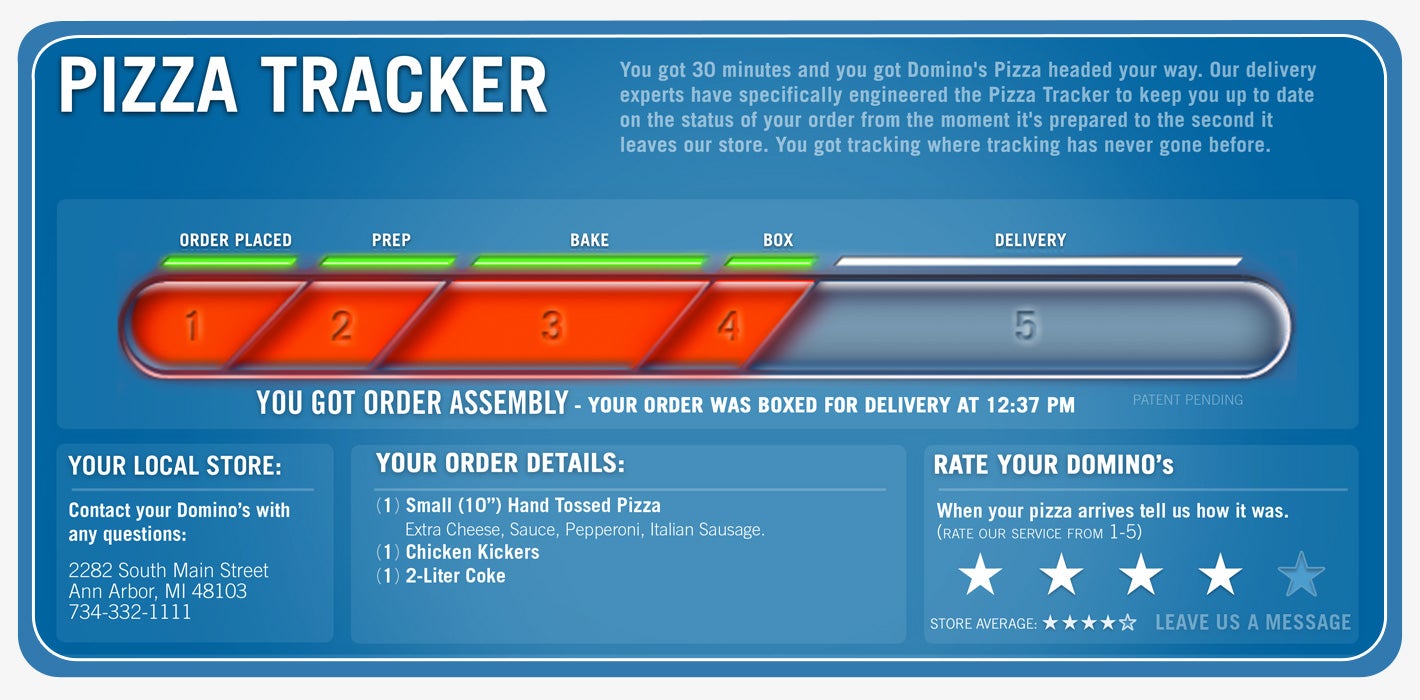
Let's say you've committed to your core message, how does the PLAN come together?
Steven Covey says you should “begin with the end in mind” and that is exactly what you've been doing. Your intention is to (re)enter the marketplace with a bold promise to solve a legitimate problem for a real person that is in pain. Each of the 4 core questions above brings clarity to how you will do that. (You've actually been planning the whole time.)
The next major question is: how does that message get out so that new clients can come in? If you do it right your pillar content will be in every place your prospective client hopes to find it.
Visually, it looks like this:
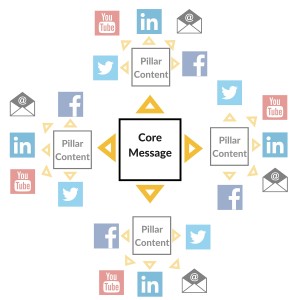
Execution of the plan looks like this:
Answer the 4 core questions and decide where you stand. Once you've decided “where you stand” it is so much easier to decide “what you write”. It's simplest to use your State of the Union address (from question #1) as your first piece of pillar content. Be loud. Be clear. Be strong. Be intentional. Amin started with one piece of pillar content. No need to focus on any more than that.
Communicate your stance by creating education based, pillar content. The exact type of content you create (audio, visual, video, written, etc) is determined by the strengths of your organization. There is no “one” magic method that is “better” that the other. Don't get hung up on that. For most organizations, creating pillar content in article format is the most efficient starting place. This is also the path Amin chose. He outlined the article, created an audio version, transcribed it, and hired a professional editor.
Publish it in every relevant place your next-level client lives. If you have constructed your pillar content correctly it can easily be repurposed without losing its potency. Your content is not only authoritative and authentic, but it is also purposeful and profitable. You now have the ability to attract new clients via any platform with education as the basis of the relationship.
You've already seen the results.
You saw what happened in Amin's business. His company used to be the 2nd (3rd, 4th, 5th …) option in his client's mind and that positioning was killing the business. He stepped back, committed to a core message, and scaled up the value he offered to the marketplace. His efforts were rewarded.
He knows the exact problem he solves.
He knows exactly who he should be selling to and where to find them.
He knows the exact content he should present to his prospective clients.
He knows he can guarantee excellence to each and every client, each and every time.
You are now moments away from a breakthrough.
The exact same result is possible for you, but only if you (re)commit to your core message and build education based, pillar content to support that message.
Is there a faster way? Yes, you can create content without committing to a core message as a fundamental guide. You can also walk through a haunted house without a flashlight. In either case, you will stumble around and eventually make a wrong turn that scares you to death. You might make it out, but then again..you might not.
Personally, I've experienced both paths. I'm much more comfortable operating with a guiding light, but the choice is yours.
Download the Core Content Strategy Guide:
If you are looking for a next step to develop more resonance, respect, power, and profitability within your target audience click the link below.
This guide is a short summary of the four core questions that build core content strategy. --> Download the Core Content Strategy Guide
Let's see how close (or far) you are from developing powerful, differentiated messaging.

All I can say is, “wow.” I’m pumped. Every business person and content marketer must read and apply this (with Alzay’s help ideally).